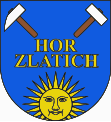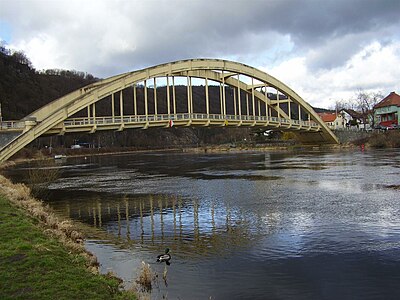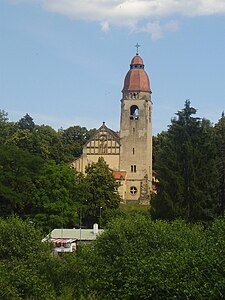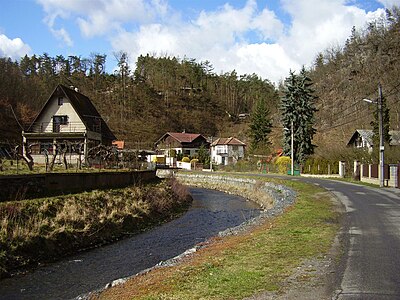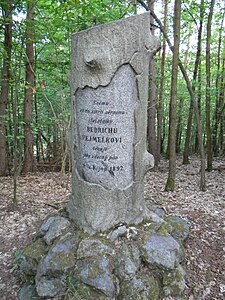Štěchovice u Prahy
| Štěchovice | ||||
|---|---|---|---|---|
|
||||
| Basic data | ||||
| State : |
|
|||
| Region : | Středočeský kraj | |||
| District : | Praha-západ | |||
| Area : | 1430 ha | |||
| Geographic location : | 49 ° 51 ' N , 14 ° 24' E | |||
| Height: | 215 m nm | |||
| Residents : | 2.002 (Jan. 1, 2019) | |||
| Postal code : | 252 07 - 252 08 | |||
| License plate : | S. | |||
| traffic | ||||
| Street: | Prague - Nový Knín | |||
| structure | ||||
| Status: | Městys | |||
| Districts: | 3 | |||
| administration | ||||
| Mayor : | Miloš Čapek (as of 2013) | |||
| Address: | Hlavní 3 252 07 Štěchovice |
|||
| Municipality number: | 539732 | |||
| Website : | www.stechovice.info | |||
| Location of Štěchovice in the Praha-západ district | ||||

|
||||
Štěchovice (German Stiechowitz ) is a minority in the Czech Republic . It is located 26 kilometers south of the city center of Prague and belongs to the Okres Praha-západ .
geography
Štěchovice is located in the north of the Středočeská pahorkatina on the edge of the Střed Čech Nature Park in the Vltava Valley . The place is on the left bank of the river at the confluence of the Kocába stream ( Kotzaba ). The Medník (416 m) and the Chlum (447 m) rise to the northeast, the Michnův vrch (429 m) and the Chlum (448 m) to the southeast, the V Leštině (400 m) and the Červená hora (486 m) to the south, in the southwest the Homole (394 m), the Ploch (382 m) and the Havran (385 m) and to the northwest the Chlumka (406 m) and the Žižkův vrch (382 m). To the east of the town is the Štěchovice dam , and to the southeast on the Chlum is the Homole reservoir of the pumped storage power plant. State road II / 102 between Zbraslav and Kamýk nad Vltavou leads through Štěchovice , from which road II / 106 branches off to Týnec nad Sázavou .
Neighboring towns are Šlemín, Brunšov, Rajchardov and Hradištko the north, Pikovice, Luka pod Medníkem, Závist and Norbert Inca un northeast, Peškov, Sídliště, Ztracení and Krňany the east, Teletín and Třebenice in the southeast, Homole, Rabyně , Lahoz, Záhoří, Slapy and Buš in the south, Porostliny, Nové Dvory , Krámy, Královky, Malá Lečice and Na Papoušku in the south-west, Bratřínov , Masečín and Bojanovice in the west and Bojov, Hvozdy and Hvozdnice in the north-west.
history
Szechowicze was first mentioned in writing in 1205 in a certificate of confirmation from King Ottokar I Přemysl about the rights and privileges of the Benedictine monastery Insula as one of the 24 monastery villages. However, the Insula monastery did not own the entire village, in 1206 Bishop Daniel Milík donated a share of Szechowicze to the Cistercian monastery Plasy . The latter part was never mentioned again later, it probably went to the Strahov Premonstratensian Monastery . In the second half of the 13th century gold mining began in the area between Davle and Slapy . In 1304 the Cistercian monastery Königsaal was assigned the Slapy court with an associated share from Štěchovice in its founding document. In a document from 1323, the insuler's share was referred to as Czechowicz Maiori and the Königsaaler as Czechowicz Minori . In 1339, King John of Luxembourg gave the Königsaal monastery the proceeds of all gold mines in the area of the Slapy court. The Goldseifner settlement Brunnseifen existed on the Insul estates opposite Štěchovice . In 1388 the insuler's share included eleven farms. In 1410, in the land register of the Strahov Premonstratensian monastery, a part of Štěchovice with 18 subjects consisting of a forecourt with forests and meadows was listed. At the beginning of the Hussite Wars , the monasteries Königsaal and Insula were looted and burned down in 1420. T. to worldly owners. In 1421, with the exception of two properties, the Königsaal share was added to the Hradischko estate ; and the Strahover share increased. 1436 Hradischko was connected with the part of Štěchovice to the rule Lešany .
Since the destroyed monastery of Insula remained largely abandoned after the end of the Hussite Wars, King Sigismund freed the Insuler's share in a letter of majesty from 1436 and elevated it to a free town. The Benedictine provostry of St. John under the rock , which administered the property of its desolate mother monastery, Insula, sued the former property against the protest of the Štěchovice residents. King Sigismund pledged the Strahov share of the town in 1437 for 430 shock groschen to Hans and Heinrich von Kolowrat . Hieronymus von Čečelice sold the Hradischko manor with the Štěchovice share in 1446 to the island's abbot Johann.
In 1499 the Benedictines pledged their share from Štěchovice to Hieronymus von Skuhrov. Later this part was attached to the Konopiště dominion . After further changes of ownership and purchases of the former Strahover share, Adam von Sternberg owned half of the town in 1547. He transferred this to the brothers Adam and Sebastian von Šanovec in 1590, after which Katharina Wratislaw von Mitrowitz , née Šanovcová, inherited the property; she later sold it to Adam d. Ä. Hozlauer from Hozlau in Hradischko. Johann von Sternberg auf Konopiště sold the other part of Štěchovice in 1571 to Jiří Slepotický von Sulice; The following owners were from 1593 Heřman Diviš and then Zuzana Šanovcová, who inherited the Štěchovice from her daughter Katharina Hozlauer von Hozlau. In 1612 Adam Hozlauer von Hozlau auf Hradischko owned the entire town of Štěchovice including the Vorwerkshof.
After the battle of the White Mountain , the property of the Protestant Adam Hozlauer was confiscated and divided up. In the berní rula from 1653, Štěchovice is listed as part of the property of the Strahov Monastery ( Gut Hradischko ), the section of St. John under the Rock ( Gut Davle ) and the Königsaal Monastery ( Gut Königsaal and Slapy ). The Štěchovice gold mining came to an almost complete standstill due to the Thirty Years' War. In 1775 two powder factories were built in the Kotzaba Valley.
In 1845 the subservient market Stiechowitz / Stěchowice or Zdechowice in the Berauner district consisted of 90 houses with 683 inhabitants, 51 of which belonged to the Hradischko manor, 38 to the Slap manor and one house to the Leschan manor . A Jewish family lived on the Hradischko part. In Stiechowitz there was a school under the patronage of the Hradischko manor, two inns and a mill. On the other side were a Hegerhaus and the Meierhof Mayerka ( Majorka ), which both belonged to the Hradischko estate, as well as two powder factories with twelve mills in the Kotzaba valley, owned by Aloys Ritter von Rosenstein and Joseph von Zummer. Both factories produced 2000 quintals of powder a year, which was delivered to the Imperial and Royal Armory in Prague. The residents lived from pottery, the timber trade and shipping. The Slaper share included two inns, two mills, a board mill and the remote Chaluppe Babuschek. The parish was St. Kilian ( Kilián ). Until the middle of the 19th century, Stiechowitz remained partly subservient to Hradischko, Slap and Leschan.

After the lifting of patrimonial formed Štechovice / Stechowitz with the districts and Masečín Třebenice a town in the jurisdiction Zbraslav . From 1868 the market belonged to the Smichow district . Masečín broke up in 1897 and formed its own community. The current form of the name Štěchovice was introduced in 1924. 1927 the Městys Štěchovice was assigned to the Okres Praha-venkov. In 1932 810 people lived in Štěchovice with Třebenice. Between 1937 and 1939 a reinforced concrete bridge was built in place of the Vltava ferry. The Štěchovice hydropower plant was built above Štěchovice between 1937 and 1945 , and the St. John's rapids on the Vltava sank in the reservoir. 1942 Štěchovice became part of the Okres Praha-venkov-jih.
At the end of the Second World War, old tunnels in the Dušno Gorge above the dam in the restricted area of the SS Pioneer School Brunschau, which belonged to the SS military training area in Bohemia , were used to store boxes. Allegedly a treasure (including the amber room) is said to have been hidden on the site . After SS-Scharführer Günther Achenbach reported in French captivity in October 1945 about the storage of 30 boxes with secret documents from Berlin, a US military convoy consisting of four trucks with technology drove to Štěchovice on February 10, 1946 and opened it in a secret operation secured and mined hiding place. The recovered boxes were brought across the German border by the US Army. After a protest by the Czechoslovak government, the US ambassador apologized for the unfortunate incident and returned the boxes with documents from State Secretary Karl Hermann Frank to Czechoslovakia.
The Vltava bridge was named most Dr. in 1946. Edvarda Beneše . In 1948 Štěchovice sank to the village. In 1949 the community was assigned to Okres Praha-jih, since 1960 it has belonged to Okres Praha-západ . Masečín was incorporated on January 1st, 1980. The Vltava flood in August 2002 caused high damage in Štěchovice, the Dr. Edvard Beneš Bridge remained undamaged. On October 10, 2006, the status of Štěchovice was renewed as Městys. Štěchovice is now a resort. In the Grund Dušno, treasure hunters are increasingly active in modern times.
Local division
The minor town Štěchovice consists of the districts Masečín ( Masetschin ), Štěchovice ( Stiechowitz ) and Třebenice ( Trebnitz ). It is divided into the cadastre Masečín and Štěchovice u Prahy and the settlement units Hvozdy, Masečín, Štěchovice and Třebenice. The locations Homole, Na Papoušku, Peškov, Sídliště and Ztracení also belong to Štěchovice.
Attractions
- Church of St. Johannes von Nepomuk in the village of Peškov, built 1911–1915 according to plans by Kamil Hilbert in secession style
- Valley of the Kocába with trampoline settlements
- Štěchovice hydropower plant with Vltava dam and pumped storage plant
- Dr. Edvard Beneš Bridge, also Štěchovický most , the 114 m long Vltava bridge between Štěchovice and Brunšov was built between 1937 and 1939 according to plans by Miloslav Klement. It was the first reinforced concrete bridge in the country with a span of over 100 meters and at the same time also the first bridge in Czechoslovakia to be built with two hollow concrete arches. In 1965 it was declared a cultural monument.
- Kobylí Draha Nature Reserve , east of Štěchovice above the Vltava River
- Stone tree in the forest between Štěchovice and Slapy; the granite memorial commemorates Heger Bedřich Vejmelka, who was murdered in 1892
- Gold mining relics on Červená hora, in Grund Dušno and on Šedivý vrch
- Attractions
Individual evidence
- ↑ Český statistický úřad - The population of the Czech municipalities as of January 1, 2019 (PDF; 7.4 MiB)
- ↑ Johann Gottfried Sommer The Kingdom of Bohemia, vol. 16 Berauner Kreis, 1849, p. 56
- ↑ Johann Gottfried Sommer The Kingdom of Bohemia, vol. 16 Berauner Kreis, 1849, p. 64
- ↑ Die Welt : Treasure Hunt in the Vltava Valley
- ↑ http://www.uir.cz/casti-obce-obec/539732/Obec-Stechovice
- ↑ http://www.uir.cz/katastralni-uzemi-obec/539732/Obec-Stechovice
- ↑ http://www.uir.cz/zsj-obec/539732/Obec-Stechovice
Web links
- History of Štěchovice (currently not available)
- Gold mining around Štěchovice (Czech)
- Find of the archive of Karl Hermann Frank (Czech)
